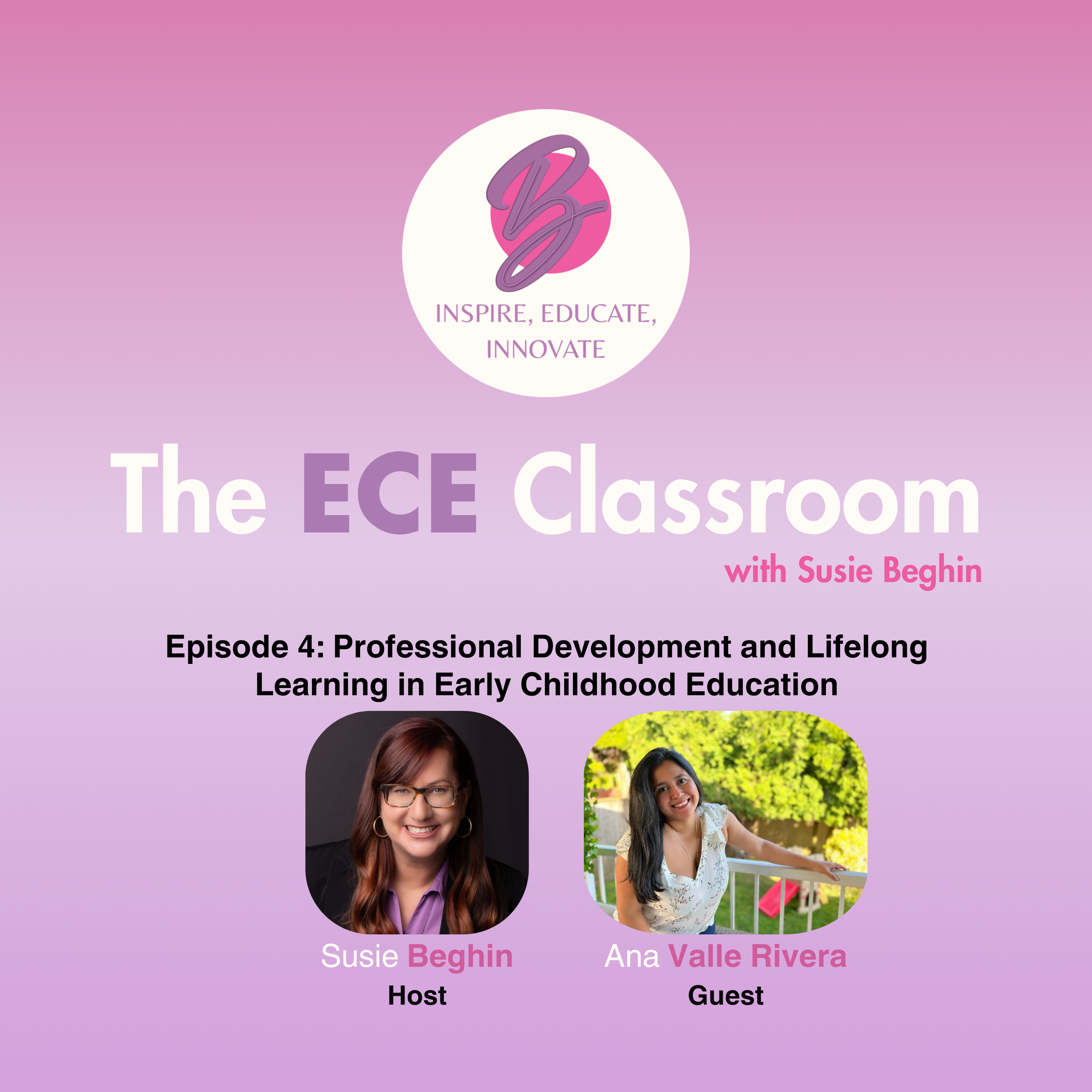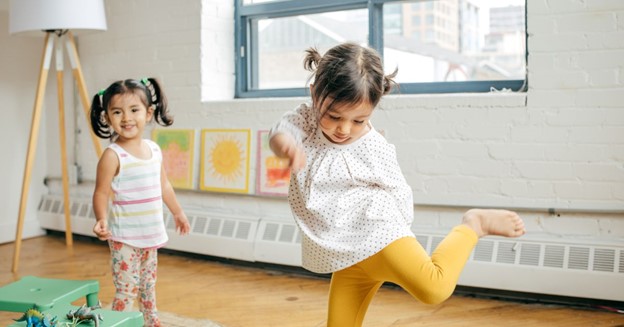The ECE Classroom – Recap of Episode 4 – Lifelong Learning and Professional Development
The ECE Classroom – Recap of Episode 4 – Lifelong Learning and Professional Development
by Susie Beghin, RECE, Founder of Alpha’s Discovery Kids
“Lifelong learning isn’t just a buzzword; it’s essential for our growth and effectiveness as educators.”
In the latest episode of my podcast, The ECE Classroom, I had the honor of discussing the importance of lifelong learning and professional development for early childhood educators with Anna Valle Rivera. The conversation was insightful and inspiring, emphasizing the crucial role continuous education plays in our professional lives and the impact it has on the children we teach.
The Importance of Lifelong Learning
Lifelong learning is an ongoing process that allows educators to stay updated with the latest teaching strategies, tools, and research. It’s about more than just attending workshops and seminars; it’s a commitment to personal and professional growth. By engaging in lifelong learning, educators can enhance their teaching practices, adapt to new challenges and meet the diverse needs of their students.
In this episode, we explored various aspects of lifelong learning, including the benefits it brings to educators and students alike. Continuous education helps teachers to stay current with educational trends, understand new research findings, and apply innovative strategies in their classrooms. This leads to more effective teaching and better learning outcomes for children.
Professional Development: Empowering Educators
Professional development is a key component of lifelong learning. It involves activities and programs designed to enhance the knowledge, skills and competencies of educators. Through professional development, teachers can gain new insights, refine their teaching methods and build their confidence.
We discussed different forms of professional development, such as attending workshops and conferences, participating in webinars and engaging in reflective practice. These opportunities provide educators with the tools they need to continually improve their practice, share experiences and stay motivated.

Practical Tips for Embracing Lifelong Learning
During the episode, I shared practical tips on how educators can embrace lifelong learning and make it a part of their daily lives:
- Attend Workshops and Webinars: Participate in local and online workshops and webinars to learn about the latest trends and strategies in early childhood education.
- Engage in Reflective Practice: Take time to reflect on your teaching experiences, identify areas for improvement and set goals for your professional growth.
- Join Professional Networks: Connect with other educators through professional organizations and online communities. These networks provide valuable resources, support and opportunities for collaboration.
- Read Educational Literature: Stay informed by reading books, journals and articles on early childhood education. This helps you keep up with new research and best practices.
- Pursue Advanced Degrees or Certifications: Consider furthering your education through advanced degrees or specialized certifications. This not only enhances your knowledge but also opens up new career opportunities.
The Impact on Children
The benefits of lifelong learning and professional development extend beyond educators. When teachers are well-informed and skilled, they can create richer, more engaging learning environments for their students. This leads to better educational experiences and outcomes for children.
Engaged and motivated educators are more likely to implement innovative practices, use effective teaching strategies and create a positive classroom atmosphere. This fosters a love of learning in children and supports their overall development. By continuously improving their practice, educators can better meet the individual needs of each child and help them reach their full potential.
Takeaways from the Episode
- Lifelong learning is vital for the growth and effectiveness of early childhood educators.
- Professional development empowers teachers to stay updated with the latest educational trends and strategies.
- Practical tips for embracing lifelong learning include attending workshops, engaging in reflective practice, and joining professional networks.
- The benefits of lifelong learning and professional development extend to children, leading to better educational experiences and outcomes.
You can learn more about Anna and her work at @earlyyearsthriving.
Stay tuned for more insightful discussions on early childhood education, parenting, and educator empowerment. Let’s continue to learn, grow, and make a difference in the lives of our students every day.
You can listen to the podcast on your favorite podcast platform, or by clicking here: https://open.spotify.com/show/7Hg7rTtRQggsVSCbbOdvP2?si=paCEPiCRRGK7yOfrTTsh8Q
Building Resilience in Young Children: Helping Them Navigate Challenges and Setbacks
Building Resilience in Young Children: Helping Them Navigate Challenges and Setbacks
by Susie Beghin, RECE, Founder of Alpha’s Discovery Kids
At Alpha’s Discovery Kids, we believe that resilience is a cornerstone of healthy development. Resilience is the ability to bounce back from setbacks, adapt to change, and keep going in the face of adversity. Developing this vital skill early in life helps children navigate the inevitable challenges and setbacks they will encounter. As parents and educators, we play a crucial role in helping children develop the resilience they need to thrive. By fostering resilience in young children, we equip them with the skills to handle stress, overcome obstacles, and maintain a positive outlook even when things get tough. This foundation is essential for their overall well-being and success in life.
Here are a few ideas and strategies for building resilience in young children, ensuring they are prepared to face life’s challenges with confidence and determination.
- Foster a Secure Attachment
A secure attachment between a child and their caregivers forms the foundation for resilience. When children feel safe, loved, and supported, they are more likely to explore their environment and take healthy risks. Consistent, responsive caregiving helps children develop trust and a sense of security.
- Encourage Independence and Problem-Solving
Allowing children to solve problems on their own encourages independence and critical thinking. When children face challenges, guide them through the problem-solving process rather than providing immediate solutions. Ask open-ended questions that prompt them to think about different strategies and potential outcomes. This approach not only builds problem-solving skills but also fosters a sense of competence and confidence.

- Model Resilient Behavior
Children learn by observing the adults around them. Model resilient behavior by demonstrating how to handle stress, setbacks, and disappointment in a positive and constructive manner. Share stories about times when you faced challenges and how you overcame them. By showing children that it is normal to experience difficulties and that they can be managed, you help them develop a resilient mindset.
4. Promote a Growth Mindset
A growth mindset is the belief that abilities and intelligence can be developed through effort and persistence. Encourage children to view challenges as opportunities for learning and growth rather than as threats to their self-esteem. Praise their efforts rather than just their achievements. This helps children understand that their abilities can improve with practice and dedication, making them more likely to persist in the face of difficulties.
5. Teach Emotional Regulation
Helping children understand and manage their emotions is crucial for resilience. Teach them to recognize and name their feelings, and provide them with strategies to cope with negative emotions, such as deep breathing, counting to ten, or taking a break.
- Create Opportunities for Mastery
Providing children with opportunities to succeed and master new skills builds their confidence and resilience. Set achievable goals and celebrate their successes, no matter how small. This sense of accomplishment reinforces the belief that they can overcome challenges and achieve their goals through effort and perseverance.
7. Encourage Positive Relationships
Strong social connections are a key component of resilience. Encourage children to build positive relationships with their peers, teachers, and family members. Teach them the importance of empathy, kindness, and cooperation.
- Establish Consistent Routines
Routines provide a sense of stability and predictability, which is particularly important for young children. Consistent routines help children feel secure and understand what to expect, making it easier for them to cope with changes and challenges. Ensure that routines are flexible enough to accommodate the child’s needs while providing a structured environment that supports their growth and development.
- Encourage Healthy Risk-Taking
Allow children to take age-appropriate risks and learn from their experiences. Whether it’s climbing a new piece of playground equipment, trying a new activity, or making a new friend, healthy risk-taking helps children build confidence and resilience.
- Promote Mindfulness and Relaxation
Mindfulness and relaxation techniques can help children manage stress and build resilience. Teach them simple mindfulness exercises, such as deep breathing, guided imagery, or progressive muscle relaxation. These practices can help children stay calm and focused, even in challenging situations.
Building resilience in young children is a vital part of helping them navigate the challenges and setbacks they will face throughout their lives. At Alpha’s Discovery Kids, we are committed to creating a nurturing environment that supports the development of resilient, confident, and capable children. By fostering secure attachments, encouraging independence, modeling resilient behavior, promoting a growth mindset, and teaching emotional regulation, we can help children build the skills they need to thrive. Through positive relationships, consistent routines, healthy risk-taking, and mindfulness practices, we equip them with the tools they need to face life’s challenges with confidence and resilience.
Mindful Parenting: Promoting Calmness, Patience, and Connection with Your Children
Mindful Parenting: Promoting Calmness, Patience, and Connection with Your Children
by Susie Beghin, RECE, Founder of Alpha’s Discovery Kids
Have you ever spent hours scouring the internet for parenting tips, seeking solutions to the daily challenges and uncertainties you face? Parenting can often feel like an overwhelming task filled with constant demands and pressures. As a mother and an Early Childhood Education (ECE) educator, I empathize with these pressures firsthand. That’s why I believe mindfulness is so crucial, not only for children but also for us adults. From my conversations with many parents, I know that mindful parenting, which integrates calmness, patience, and a deep connection with our children, is of utmost importance.
Mindful parenting involves being fully present and engaged with your children, fostering a deep sense of awareness and connection. It’s about slowing down, appreciating the moment, and responding to your child’s needs with empathy and understanding. Mindfulness in parenting helps create a supportive environment where children feel valued, heard, and loved. This approach not only benefits the children but also promotes the well-being of parents, reducing stress and enhancing the overall family dynamic.
In this blog, I’ll share some tips that I hope you find helpful in incorporating mindful parenting into your daily life. These tips are designed to help you nurture calmness, patience, and a stronger connection with your children, fostering a positive and supportive family environment.

Tips to Promote Calmness
- Practice Self-Care: Before you can be present for your children, it’s crucial to take care of yourself. Ensure you are getting enough rest, eating well, and engaging in activities that rejuvenate you. Self-care isn’t selfish; it’s necessary for maintaining your well-being and being the best parent you can be.
- Breathing Exercises: Simple breathing exercises can help both you and your children manage stress and stay calm. Practice deep breathing techniques together, especially during moments of tension. Inhale deeply through the nose, hold for a few seconds, and exhale slowly through the mouth.
- Create a Calm Environment: Your home environment significantly affects your family’s mood and behavior. Keep your living space organized and clutter-free to create a sense of tranquility. Soft lighting, calming music, and incorporating natural elements can also contribute to a peaceful atmosphere.
Tips to Promote Patience
- Practice Mindfulness Meditation: Regular mindfulness meditation can help you develop greater patience. It trains your mind to stay focused on the present moment and reduces impulsive reactions. Even a few minutes of meditation each day can make a significant difference.
- Empathize with Your Child: When your child is acting out, try to see the situation from their perspective. Understanding their feelings and frustrations can help you respond with empathy rather than impatience. Remember, children are still learning how to navigate their emotions and the world around them.
- Set Realistic Expectations: Recognize that children are still developing their skills and may not always meet your expectations. Adjusting your expectations to their developmental level can reduce frustration and help you respond more patiently.
Tips to Promote Connection
- Engage in Shared Activities: Spend quality time with your children doing activities they enjoy. This could be reading together, playing games, or simply talking. Shared activities foster a strong bond and show your children that you value spending time with them.
- Listen Actively: Active listening involves giving your full attention to your child when they speak. Make eye contact, nod, and respond appropriately to show that you are engaged in the conversation. This practice helps your child feel heard and understood.
- Express Love and Appreciation: Regularly express your love and appreciation for your children. Positive affirmations, hugs, and kind words go a long way in building a strong emotional connection. Let your children know that they are loved unconditionally.
Mindful parenting is a journey that requires practice and patience, but the rewards are profound. By incorporating mindfulness into your parenting approach, you can promote calmness, patience, and a deep connection with your children. Remember to take care of yourself, practice empathy, and engage in meaningful activities with your children. These practices will help create a supportive and loving environment where your children can thrive.
For more insights and practical tips on fostering your child’s development through play and mindfulness, I invite you to explore my book, Learn to Play. It’s a comprehensive guide designed to help parents and educators provide the best start in life for their children.
By adopting these mindful practices, we can transform our parenting approach, ensuring that we raise happy, healthy, and well-rounded children.
Navigating the Transition: Helping an Older Sibling Adjust to a New Baby
Navigating the Transition: Helping an Older Sibling Adjust to a New Baby
by Susie Beghin, RECE, Founder of Alpha’s Discovery Kids
As both a mom and an early childhood educator, I understand the challenges families face when welcoming a new baby into the home. The arrival of a new sibling can be an exciting yet challenging time for older children, especially when it comes to adjusting to the changes in their daily routine and family dynamics. At Alpha’s Discovery Kids, we’re committed to supporting families at every stage of their journey, providing guidance and assistance to help children and parents navigate this transition with ease.
It’s not uncommon for children to experience a range of emotions during this time, and these feelings often manifest in their behavior at daycare. From regression in previously mastered skills to attention-seeking behaviors and separation anxiety, the changes happening at home can significantly affect a child’s behaviour and well-being in the daycare environment.
Here are five common observations we see in the daycare setting:
1.Child Regression in Skills:
- Children may regress in skills they’ve previously mastered. For example, a child who was once independent at nap time may suddenly need more help falling asleep.
2. Attention-Seeking Behavior:
- Some children may exhibit attention-seeking behavior in negative ways, such as whining, hitting, or biting, to garner more attention.
3. Separation Anxiety:
- Older siblings may experience strong separation anxiety at drop-off time, even if they’ve previously adjusted well to daycare.
4. Reluctance to Attend Daycare:
- Children may express a desire to stay at home with the parent rather than attending daycare.
5. Engagement in “Baby Talk”:
- Children may revert to “baby talk” even if they can speak in full sentences.

It’s crucial for parents to communicate these changes with their daycare teachers. Understanding the child’s situation at home enables us to provide the best support and assistance at daycare.
Here are some strategies you can try to help children adjust to the change:
Acknowledge the Child’s Feelings:
- Validating the child’s emotions is crucial. Let them know that it’s okay to feel sad, mad, or jealous about the new addition to the family. For example, you might say, “It’s hard to be a big sister! You sometimes feel sad or mad that mom and dad are busy with your little brother.”
Acknowledge Good Behavior:
- Children often seek attention, even if it’s negative. Instead of focusing on negative behavior, emphasize and praise positive behavior. For instance, you might say, “I like how you helped your little brother with his bath this morning,” or “I appreciate how you waited patiently for me to finish talking on the phone before you came to ask me something.” Specific praise encourages the child to repeat desirable behavior.
Avoid Making Big Changes:
- It’s advisable to avoid making other significant changes during this time. For instance, hold off on starting potty training or weaning. Minimizing changes can help the child adjust more smoothly.
Continue Treating the Child According to Their Age and Skill Level:
- If you notice regression in the child’s behavior, it’s essential to continue treating them according to their age and skill level. Offer opportunities for age-appropriate activities to help them build and maintain their skills.
With patience, understanding, and support, both parents and children can navigate this transition successfully. Enjoy this special time by spending extra one-on-one time with each other as well as quality time together as a family!
For video content on this topic and similar early childhood topics, visit our YouTube channel.
Parenting in the Digital Age: Screen Time
Parenting in the Digital Age: Screen Time
by Susie Beghin, RECE, Founder of Alpha’s Discovery Kids
Parenting in the digital age can feel like navigating uncharted territory. As a parent and the owner of Alpha’s Discovery Kids, I am acutely aware of the complexities involved in raising children in an era dominated by technology. In our rapidly evolving world, where digital devices are part of our everyday lives, finding the right balance between harnessing the benefits of technology and safeguarding against its potential drawbacks is crucial. At Alpha’s Discovery Kids, we prioritize creating an environment where children can thrive emotionally, socially, and intellectually while also recognizing the role that technology plays in their lives. Striking this balance is essential as we help guide children through their formative years.
One of the most pressing concerns for parents is managing screen time limits. With smartphones, tablets, and other digital devices becoming increasingly prevalent, children are spending more time than ever in front of screens. This is why it’s so important to focus on creating a balance between embracing technology for educational purposes and ensuring children have ample opportunities for real-world experiences and interactions. After all, children learn best through play so we want to make sure we are encouraging them to participate in activities such as outdoor play, social interactions and creativity.

Quality of content is another major consideration for parents navigating the digital landscape. With countless apps, games, and digital platforms available to children, it’s essential to curate content that is not only entertaining but also enriching, age-appropriate, and safe. Parents must discern between educational content that fosters learning and critical thinking skills and potentially harmful or addictive material. It’s equally important to make sure that the digital content aligns with family values and educational goals – just one more layer of complexity to the decision-making process!
The impact of technology on children’s social and physical development also cannot be overlooked. Excessive screen time has been linked to a sedentary lifestyle, which can contribute to a decline in physical activity and overall well-being. Additionally, prolonged use of digital devices can sometimes replace face-to-face interactions, affecting children’s social skills and emotional development.
Despite these challenges, we believe that technology can be a valuable tool when used appropriately. At Alpha’s Discovery Kids, we incorporate technology into our curriculum in a way that enhances learning experiences and fosters creativity, striving to provide children with opportunities to engage with technology in meaningful ways.
We also encourage open communication about technology. By discussing the benefits and potential drawbacks of technology with children, parents can help them develop healthy digital habits and make informed choices about their screen usage.
Ultimately, parenting in the digital age requires a thoughtful and proactive approach. By creating a balance between technology and real-world experiences, setting clear guidelines for screen time, and fostering open communication, parents can help their children navigate the digital world safely and confidently. At Alpha’s Discovery Kids, we are committed to supporting parents in this journey and providing children with the tools they need to thrive in today’s digital age.
For more information on early childhood topics, follow Susie Beghin’s YouTube channel where she delves deeper into these topics.
Fostering Early Literacy: Strategies to Inspire a Love of Reading
Fostering Early Literacy: Strategies to Inspire a Love of Reading
by Susie Beghin, RECE, Founder of Alpha’s Discovery Kids
Did you know that the foundation for a lifelong love of reading is laid in the earliest years of childhood?
As an Early Childhood Educator and a mother, I am deeply passionate about fostering a love for reading from an early age. At Alpha’s Discovery Kids, we are always exploring natural ways to incorporate language and literacy into our play-based approach to learning. After all, research indicates that the peak ability to learn occurs between the ages of 0 to 6 years, so building strong literacy skills in the early years is crucial for a child’s overall development. The key is incorporating various strategies to make learning enjoyable and effective.
Teaching literacy through free play is one of the most effective ways to engage children and foster a love for reading, and something we do every day at Alphas Discovery Kids! By creating a “print-rich” environment, we surround children with written words and labels that correspond to everyday objects. For example, labeling items with both a picture and written word helps children make associations between the spoken word and its written form. Whenever we engage with these labeled items during work time, we point out the written word, reinforcing the connection between spoken language and print.

In addition to labeling, we use Jolly Phonics songs as a fun and engaging way to develop associations between letter sounds and letter names. Singing alphabet songs or rhymes helps children become familiar with the sounds of letters while providing a memorable and enjoyable experience.
When it comes to reading books, we believe in making the experience interactive and engaging. Instead of simply reading aloud, we encourage children to participate by asking them questions about the story and what they think will happen next. This not only promotes critical thinking skills but also encourages children to actively engage with the text and develop comprehension skills.
We can also empower children to tell their own stories by interpreting pictures on a page or creating their own narratives based on the illustrations. This encourages creativity and imagination while also strengthening language and storytelling abilities.
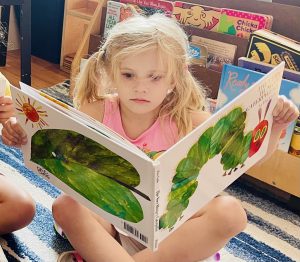 Intentional literacy activities can be tailored to suit children at different stages of development. For infants, daily read-aloud sessions provide valuable opportunities for brain development and foster a sense of curiosity about the world. As children transition into the toddler stage, tactile activities such as using alphabet magnets or drawing letters in sand help introduce them to the alphabet in a hands-on way. A quick tip is to start with 5 to 7 letters and gradually add more as children learn. This ensures that they can build upon their knowledge at a pace that suits them.
Intentional literacy activities can be tailored to suit children at different stages of development. For infants, daily read-aloud sessions provide valuable opportunities for brain development and foster a sense of curiosity about the world. As children transition into the toddler stage, tactile activities such as using alphabet magnets or drawing letters in sand help introduce them to the alphabet in a hands-on way. A quick tip is to start with 5 to 7 letters and gradually add more as children learn. This ensures that they can build upon their knowledge at a pace that suits them.
For preschoolers, we introduce the alphabet scavenger hunt as a fun and interactive way to reinforce letter recognition and early literacy skills. Children are encouraged to search for objects that begin with specific letters, promoting active engagement and exploration while strengthening their understanding of the alphabet.
By incorporating these strategies into our curriculum at Alpha’s Discovery Kids, we aim to instill a lifelong love for reading and learning in children from a young age. By making literacy fun, interactive, and accessible, we empower children to become confident and enthusiastic readers, setting them up for success in school and beyond.
For more information about this and other early childhood education topics, check out our YouTube videos.
Embracing Winter: Battling the Blues
Embracing Winter: Battling the Blues
by Susie Beghin, RECE, Founder of Alpha’s Discovery Kids
As we get to the end of February in a cold climate, it’s not uncommon for adults to find themselves grappling with the winter blues. Unlike children, many adults shudder at the thought of heading out into the frigid temperatures. Paired with the often grey skies, winters can be a struggle for many people. However, at Alpha’s Discovery Kids, we believe that with a mindful approach, parents can not only navigate but also turn the winter season into a time of warmth, connection, and family well-being.
Here’s some tips to help battle those winter blues:
- Outdoor Adventures:
Many adults look at winter as a period of hibernation. But venturing outdoors, even in colder temperatures, can significantly impact your mood and overall well-being. Make it a family affair—whether it’s building snow forts, taking a winter hike, or engaging in a friendly snowball fight, these outdoor activities offer an excellent way to bond with your children while boosting everyone’s spirits.
- Dress for the Occasion:
Don’t let the chill keep you indoors. Equip yourself and your family with the appropriate winter gear. Bundle up in layers, ensuring warmth and comfort during your outdoor excursions. The simple act of dressing for the weather can make the outdoors more inviting, allowing you (and your children) to fully enjoy the wonders of the winter landscape.
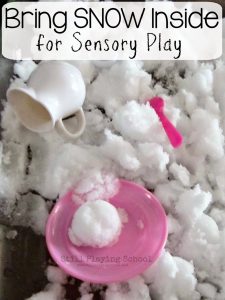
- Create a Winter Wonderland at Home:
Sometimes, the best adventures are closer than you think. Transform your home into a cozy winter haven. Get creative with indoor activities, exploring snow indoors (yes it’s possible), baking seasonal treats, or even having a family movie night with films that celebrate the magic of winter. By bringing the warmth indoors, you create a nurturing environment that counters the chill outside.
- Mindful Moments:
Winter provides a unique opportunity for mindfulness. Encourage quiet moments of reflection, perhaps by the fireplace or with a warm cup of cocoa. Incorporate mindfulness practices into your routine, such as deep breathing or simple meditation. These moments of calm can be grounding, fostering a sense of peace and emotional well-being.
- Stay Connected:
Winter blues often come with a sense of isolation. Combat this by staying connected with friends and family. Plan winter-themed gatherings or virtual meet-ups. Building a sense of community, even from a distance, can alleviate feelings of loneliness and contribute to a more positive winter experience.
- Plan for Physical Activity:
Physical activity is a powerful tool in combating the blues. Plan regular exercise sessions, whether it’s indoor workouts, winter sports, or simple stretching routines. Not only does this boost your mood, but it also sets a positive example for your children, instilling the value of staying active even during the colder months.
By taking a proactive and family-centered approach, parents can turn the winter season into a time of connection, joy, and shared experiences. At Alpha’s Discovery Kids, we recognize the importance of family well-being, and we encourage parents to see the beauty and warmth that winter can bring when approached with a positive mindset. Let this winter be a season of togetherness, creating lasting memories that your family will cherish.
For more information and early childhood tips, follow Susie Beghin on YouTube.
Winter Activities for Kids: Keeping Kids Active and Engaged
Winter Activities for Kids: Keeping Kids Active and Engaged
by Susie Beghin, RECE, Founder of Alpha’s Discovery Kids
As a mother and early childhood educator, I have witnessed the transformative influence that offering children a well-rounded educational journey can have. And at Alpha’s Discovery Kids, our commitment to giving children the best start in life is embodied in our 4 Pillars of Learning. These pillars, including Language & Literacy, STEAM, Physical Activity & Nutrition, and Mindful Awareness, form the foundation for providing children with the best start in life.
Among these pillars, Physical Activity & Nutrition hold a special place. It’s not merely about keeping young bodies in motion; it’s a holistic approach that nurtures the mind and promotes overall well-being. Even during the winter months, when the cold might tempt us to stay indoors, incorporating physical activity remains key.

Cold weather doesn’t have to mean a halt to outdoor play. At Alpha’s Discovery Kids, we recognize the importance of engaging children in physical activities, even when the temperature drops. The benefits of physical activity extend far beyond the obvious physical advantages. While it undoubtedly promotes physical health by enhancing bodily functions, building strength, and supporting the development of bones and muscles, its impact on mental and emotional health is equally significant. Physical activity has been shown to elevate mood, reduce stress, and foster a positive mindset from an early age.
And although, as adults, we don’t always enjoy heading out into the cold, most children tend to love it! Winter provides unique opportunities for physical activities that are not only enjoyable for children but also contribute to their development. Sledding, snowball fights, and building snowmen are not just recreational; they enhance gross motor skills, encourage teamwork, and promote creativity. These activities keep kids active and contribute to their social and emotional growth.
In addition to outdoor play, indoor physical activities are equally important during the winter. Parents play a pivotal role in encouraging physical activity at home, especially when outdoor play might be limited. On days when heading outdoors is challenging, there are numerous indoor activities that you and your child can enjoy, all with household items you likely already have. Here are a few ideas:
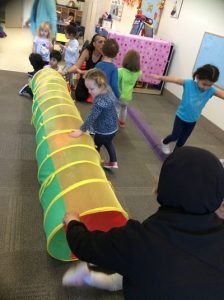
- Magical boxes – Provide your child with a large box and witness its transformation into fire trucks, tunnels, or a fantastic canvas for painting.
- Pillow paradise – Pillows can be more than just for resting. Try crafting an obstacle course or a cozy pillow fort for endless fun.
- Dance party extravaganza – Discover music the whole family enjoys and let loose with a dance party. It’s a fantastic way to get everyone moving and grooving.
- Scavenger hunt quest – Get creative with hiding spots and organize an entertaining scavenger hunt.
- Family flex– Engage in easy stretching exercises suitable for the entire family. It’s a great way to stay active and flexible.
These indoor activities not only keep your children physically active but also incorporate elements from the STEAM pillar (Science, Technology, Engineering, Art, and Math). Building a pillow or blanket fortress enhances engineering skills, and using a box as a canvas introduces artistic elements. Beyond the physical benefits, these activities stimulate young minds and foster a love for learning.
As winter sets in, don’t let it dull the sparkle of your kids’ activity. Integrating physical activity into their routine, even during the colder months, has a profound positive impact. The key is to make it fun and seamlessly woven into daily life. So, let’s embrace the winter wonderland and ensure that, even in the cold, our children are active and engaged.
For more early childhood education tips , check out my YouTube videos.
Winter Safety Tips for Kids: Keeping Your Little Ones Cozy and Secure
Winter Safety Tips for Kids: Keeping Your Little Ones Cozy and Secure
by Susie Beghin, RECE, Founder of Alpha’s Discovery Kids
As parents, caregivers, and educators at Alpha’s Discovery Kids, our goal is to provide children with the best possible start in life. We understand the importance of guiding and supporting them in various aspects, especially when it comes to their safety. When winter sets in and our surroundings become blanketed in snow, it’s crucial to ensure that our children are not only warm and comfortable but also safe during outdoor activities.
At Alpha’s Discovery Kids, children are encouraged to play outdoors for two hours per day, even during the winter months, unless the weather conditions are deemed unsafe. This time spent outdoors is invaluable for their physical well-being, social development, and connection with the world around them. However, for this outdoor adventure to be both fun and secure, it’s important to keep a few winter safety tips in mind.

Dress your children appropriately for the weather
Ensuring your children are appropriately dressed for the weather is crucial and layers are key. Layering allows your child to adjust their clothing according to the temperature and their activity level. When it’s cold outside, those multiple layers act as a thermal barrier, trapping warm air close to the body while shielding against the chilling winds. Proper winter attire should include a warm base layer, an insulating layer to keep them cozy, and a waterproof and windproof outer layer. Don’t forget to cover the extremities, too; warm mittens or gloves, a snug hat, and insulated, waterproof boots will keep your child’s fingers, head, and feet warm and dry.
While we focus on dressing for winter success, we should be aware of the more subtle risks of winter attire. Scarves and hood strings, for example, can present strangulation hazards for small children. To minimize this risk, consider neck warmers or drawstrings that release easily to protect against the dangers associated with traditional scarves and hoods.
Loose clothing is also a concern during the winter season. Loose garments can become caught on playground equipment or present tripping hazards, particularly in the snow. Make sure your child’s winter clothing is well-fitted and not excessively loose to reduce these risks.
Be aware of winter hazards
Winter is a wonderland for kids; snowball fights, building snowmen, and sliding down snow-covered slopes are some of the joys they look forward to. However, as caregivers, we are aware of the dangers, such as snowbanks near roads or the risk of kids playing near snowplows. It’s essential to educate children about playing safely and set clear boundaries. They should understand the potential dangers and learn how to avoid them, especially near streets and roads.
We’ve all heard the phrase, “Children should be seen and not heard,” but during the winter, it’s about them being seen and not hidden. Bright clothing, particularly reflective gear, is a must. With the days growing shorter and the sun setting early, visibility becomes a safety concern. Reflective materials on your child’s outerwear and backpack help ensure they are visible to drivers during those dark winter days.

Child playing with snow in winter.
As the snow and ice cover the ground, it’s crucial for children to understand that it’s essential to stay away from roads, open water such as rivers and lakes, or thin ice. They might be enticed by the allure of frozen ponds or lakes, but the ice’s thickness can be deceiving. Teach them the risks associated with thin ice and remind them to keep a safe distance.
Despite the cold temperatures and snowy landscapes, wintertime is a season filled with endless opportunities for outdoor play and adventure. Children love exploring the winter wonderland, building snowmen, and making snow angels. It’s our responsibility as parents and caregivers to provide them with the knowledge and the attire they need to enjoy these experiences safely. At Alpha’s Discovery Kids, we encourage children to embrace the magic of winter, fostering their love for the season while keeping them cozy and secure. So, when winter arrives, don’t keep your children indoors; let them go out and explore the beauty and excitement of this season.
For more information about topics related to early childhood, check out my YouTube videos.
Holiday Gift Ideas for Toddlers and Preschoolers
Holiday Gift Ideas for Toddlers and Preschoolers
by Susie Beghin, RECE, Founder of Alpha’s Discovery Kids
As the holiday season approaches, parents of young children, especially those with infants and toddlers, may find themselves swept up in the whirlwind and stress of preparations, gift buying, and festivity planning. As a parent myself, I understand that we’re often tempted to rush through the holiday preparations – the shopping, the decorating, and the meal planning – and, in the process, we can sometimes forget the profound significance of being present. The act of slowing down and being fully engaged with our little ones is, perhaps, one of the most special gifts we can offer them.
At Alpha’s Discovery Kids, we’ve always emphasized the importance of presence, and understand the magic of a child’s first few years of life is irreplaceable. These are the years when their brains absorb knowledge like sponges, and their hearts open wide to the love and warmth of family. For parents of young children, it’s a chance to slow down, savor the little moments, and enjoy the glow in their children’s eyes as they discover the magic of the season.
With the constant demands of work and daily life, these special moments with our children are a gift beyond measure. Whether it’s a quiet evening by the fireplace, a snowball fight, or simply enjoying a warm cup of cocoa, focusing on the present moment and embracing the joy of togetherness creates lasting memories.
That said, for many families, the holidays are also a time for gift-giving. But it’s easy to get swept up in the latest toy trends and gadgets. Interestingly enough, it’s often not the flashiest or most expensive gift that young kids want; it’s something that engages their developing minds, encourages creativity, and fosters fun. Being mindful when buying gifts for our children can go a long way in ensuring they are gifts that keep on giving.
So, instead of scrambling to buy the latest fad, consider gifts that align with our 4 Pillars of Learning.
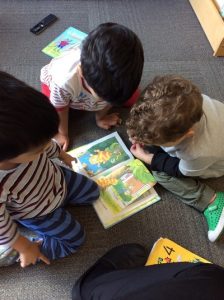
- Language & Literacy:
Beyond age-appropriate books, consider toys like sandpaper letters or magnetic letters that make learning the alphabet an engaging experience.
- Sandpaper Letters: These tactile tools help children connect letters with their shapes, enhancing early literacy skills.
- Magnetic Letters: Perfect for introducing young ones to the alphabet and word-building in an interactive way.

- STEAM (Science, Technology, Engineering, Art, and Math):
With a wide range of options, here are some ideas to explore:
- Science – Magnifying Glass: Spark your child’s curiosity with a tool that opens up the world of exploration.
- Technology – A Digital Microscope: An engaging combination of technology and science, allowing young minds to examine the world up close.
- Engineering – Building Blocks: Wooden building blocks are a classic toy that nurtures creativity and spatial skills.
- Arts – Art Supplies: From playdough to various types of paint and paintbrushes, these tools help children express themselves creatively.
- Math – Math Counters and Math Cubes: Fun manipulatives that make learning math concepts enjoyable.

- Physical Activity & Nutrition:
Encouraging physical activity and promoting healthy nutrition for young children is not only vital for their well-being but also a wonderful gift in itself.
- Riding Toys – These encourage physical activity (whether a bike or a riding car)
- Pretend Play Food: Encourage imaginative play and teach young ones about nutrition with pretend food sets.

- Mindfulness:
You can never go wrong with gifts that encourage mindfulness.
- Be Kind Cubes: These cubes offer a fun way to teach children about kindness and empathy, important attributes that align with the pillar of mindful awareness.
- Sensory materials or tables: The materials encourage children to use their senses and evoke a sense of calm.
Remember, the best gifts for young children are those that nurture their development and foster their growth through the joy of learning through play.
Practicing mindfulness during this season is a gift we offer both to ourselves and our little ones. So, let’s take it slow, savor every moment of this season, and treasure the magic of the present with our children.
For more information on early childhood education topics, check out my YouTube videos or to book a tour, please contact us.

